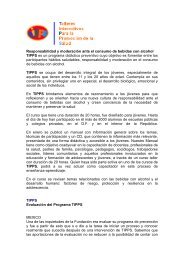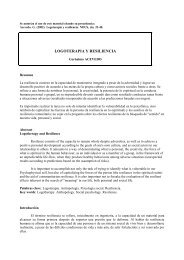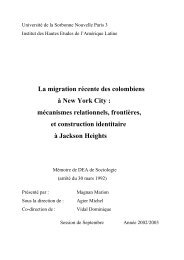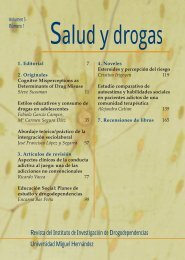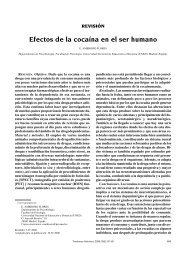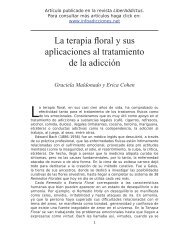migrant women in the United Arab Emirates
migrant women in the United Arab Emirates
migrant women in the United Arab Emirates
You also want an ePaper? Increase the reach of your titles
YUMPU automatically turns print PDFs into web optimized ePapers that Google loves.
e applied for <strong>women</strong>; <strong>the</strong> percentage of illiterate national <strong>women</strong> decreased with 11 per<br />
cent while <strong>in</strong> <strong>the</strong> case of non-national <strong>women</strong> this was only 1.6 per cent. A similar image<br />
could be seen <strong>in</strong> <strong>the</strong> case of those who only read and write. The category of read and write<br />
represent <strong>the</strong> very low educated which is still much higher among non-nationals, and is<br />
decreas<strong>in</strong>g very slowly, contrary to <strong>the</strong> case of nationals.<br />
If we look at <strong>the</strong> secondary level of education, we see that it improved by 11.5 per<br />
cent for male nationals while it is only 1 per cent for non-national men. Ano<strong>the</strong>r obvious<br />
<strong>in</strong>crease <strong>in</strong> education is seen among <strong>United</strong> <strong>Arab</strong> <strong>Emirates</strong> <strong>women</strong> <strong>in</strong> <strong>the</strong> graduate level<br />
where <strong>the</strong> <strong>in</strong>crease have reached 17 per cent while for <strong>the</strong> non-national <strong>women</strong> this was<br />
only 2 per cent.<br />
1.3. Population polemics and security issues<br />
At <strong>the</strong> turn of <strong>the</strong> century, <strong>the</strong> population of <strong>the</strong> <strong>United</strong> <strong>Arab</strong> <strong>Emirates</strong> was around<br />
80’000. Almost all were citizens of <strong>the</strong> region and <strong>the</strong> population growth rate was slow:<br />
over <strong>the</strong> next sixty years <strong>the</strong> number of <strong>in</strong>habitants <strong>in</strong>creased by a mere 6’000. Most of<br />
<strong>the</strong>m were nationals (M<strong>in</strong>istry of Plann<strong>in</strong>g, General Population Census; Faris 1996;<br />
Taryam 1986). But <strong>in</strong> less than five years after <strong>the</strong> first export of oil, <strong>the</strong> number of<br />
expatriates <strong>in</strong> <strong>United</strong> <strong>Arab</strong> <strong>Emirates</strong> rose to 66’000, account<strong>in</strong>g for 37 per cent of <strong>the</strong><br />
whole population dur<strong>in</strong>g <strong>the</strong> year 1968 (M<strong>in</strong>istry of Plann<strong>in</strong>g 1994). In 1975, only four<br />
years after <strong>the</strong> establishment of <strong>the</strong> <strong>United</strong> <strong>Arab</strong> <strong>Emirates</strong> federation, 356’000 foreign<br />
workers were <strong>in</strong> <strong>the</strong> country, represent<strong>in</strong>g an average of 64 per cent of <strong>the</strong> population.<br />
Today, <strong>the</strong> expatriate community comprises more than 80% of <strong>the</strong> population, a per<br />
centage unmatched anywhere else <strong>in</strong> <strong>the</strong> world. Nationals make up less than one-quarter of<br />
<strong>the</strong> whole population 2 (M<strong>in</strong>istry of Plann<strong>in</strong>g, 2000, Faris 1996; Taryam 1987; al-Hamad<br />
1994). Table 5 below is a reflection of this reality and <strong>the</strong> cont<strong>in</strong>uous decrease of Nationals<br />
<strong>in</strong> <strong>the</strong> <strong>United</strong> <strong>Arab</strong> <strong>Emirates</strong> population.<br />
Table 5:<br />
Population changes <strong>in</strong> <strong>the</strong> <strong>United</strong> <strong>Arab</strong> <strong>Emirates</strong><br />
Year<br />
Total<br />
population<br />
Nationals % Expatriates %<br />
1968 180’425 114’607 63.5 65’818 36.5<br />
1975 557’887 201’544 36.1 356’343 63.9<br />
1980 1’042’099 290’544 27.9 751’555 72.1<br />
1985 1'379’303 396’114 28.7 983’189 71.3<br />
1995 2'411’041 587’330 24.4 1’823’711 75.6<br />
Source: M<strong>in</strong>istry of Plann<strong>in</strong>g, Central Department of Statistics, 1986, 1997.<br />
The demographic gap <strong>in</strong> <strong>the</strong> <strong>United</strong> <strong>Arab</strong> <strong>Emirates</strong> between nationals and <strong>migrant</strong><br />
workers has many social, political and even security implications. When policy makers<br />
designed <strong>the</strong> migration policies <strong>in</strong> 1970, <strong>the</strong>y were not fully aware of <strong>the</strong> implications.<br />
Labour, semi-skilled and unskilled workers, was imported under temporary contracts and<br />
<strong>the</strong>se people were denied political, civ il and naturalization rights, but granted education<br />
and medical benefits (MERIP Report 1985).<br />
2 The topic is of great concern to all political figures <strong>in</strong> <strong>the</strong> country. The issue is very sensitive and relative<br />
statistics are top-secret. Officials <strong>in</strong> <strong>United</strong> <strong>Arab</strong> <strong>Emirates</strong> stopped carry<strong>in</strong>g out <strong>the</strong> five-year census <strong>in</strong>1985.<br />
Most official numbers today are based on speculation.<br />
UAE Work<strong>in</strong>g Paper_1 7



